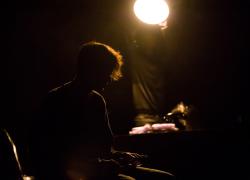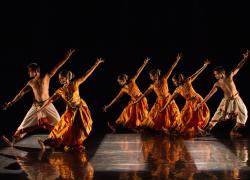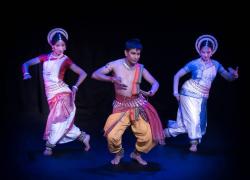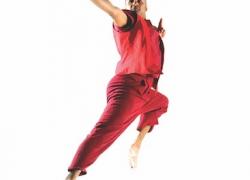Samsara – Aakash Odedra Company
Samsara
Aakash Odedra Company
Sadlers Wells, 18 October 2022
Reviewed by Pranav Yajnik
Photo: Nirvair Singh Rai
Samsara opens with Hu Shenyuan, liquid-limbed and bare-bodied under a wash of light. The desert wind begins to howl.
Dusty from the road, two travellers from lands separated by desolate expanses flit in and out of view through the narrow trapezoidal prisms of Yaron Abulafia's lighting: the colonnades of a long-abandoned city, or the contiguous spaces of day and night. Either way, the journey of many days. Each passes, then glimpses, then tracks down the other.
First meetings mean shock, miscommunication, and conflict; these give way to interaction, connection and understanding; an eventual binding together into a seamless unity. And when these two performers enter a section where their bodies form the two halves of one being that metamorphoses into a new form at every point on the spectrum between the Daoist and the Hindu, we are brought forcefully up against the concept of cultures that grew not in aloof isolation, but in vigorous and productive engagement with each other across their boundaries, to create new ideas, thought, and philosophy.
The two dancers are virtuosos. There is always a consequent risk that the dancing becomes showy; but not so here. That they have created and are able to transmit to the audience their chemistry is one of Hu and Odedra’s greatest achievements: the on-stage connection between them is one of the soul, and from the moment they meet there is not a moment where we can consider one without the other. This is despite their very different physicalities: Odedra embodies a twisting tangle of compressed power, whereas there is a stillness within Hu which is always manifest even in the fastest of movements. They dance together so harmoniously, that from those differences they make complements.
They wear the movement vocabulary effortlessly, with the result that it seems bespoke to them. Classical form, while apparent from time to time, is not the focus throughout and it is when the dancers are not occupied with the rigidity of classical form that the dancing has the greatest impact. The mostly live music is eclectic and excellent, taking in live drumming by Beibei Wang and Michael Ormiston’s Mongolian throat-singing. Nicki Wells’ compositions pierce the heart of the choreography and the audience. One of the most affecting pieces is when she sings to a section in which Odedra’s journey seems broken. He strives, he sinks, he fails: but Hu does not let him give up: “The end is coming,” Odedra seems to say; but Hu replies, “Not just yet.” Their shared humanity is profoundly moving; by that faith in the other, by that belief, the piece wrenches our hearts; and the fleeting embrace, when it arrives, is a tenderness for which the audience has unwittingly hungered.
The achievements of the past are lost in the last quarter of the piece: sand pours from the heavens to cover what has been made, a slow oblivion. We have come full circle and returned to the uninhabitable wastes where the piece began. Beneath the pouring sand, however, the dance goes on.
Monier-Williams glosses 'samsaara' as (among other things) 'passage', 'transmigration', 'passing through a succession of states'. Here, in the whip of Odedra's arcing arms and in the languid reaches of Hu’s body, the fluid dance starkly counterpoints the arid surroundings, until even the very grains of falling sand seem transmuted to the droplets of a streaming cascade; the dancers spin and bathe under the sand; and – for a few moments – there is all the joy of water.
The piece closes in much the same manner it began; but we are now irrevocably changed. It is another revolution around the helix, another definition of ‘samsara’, another hypnotically arresting visual. Dancing alone under the wash of light, Hu, a being of quicksilver, is reborn unto the endless cycle of existence.
Aakash Odedra Company Samsara Tour




















